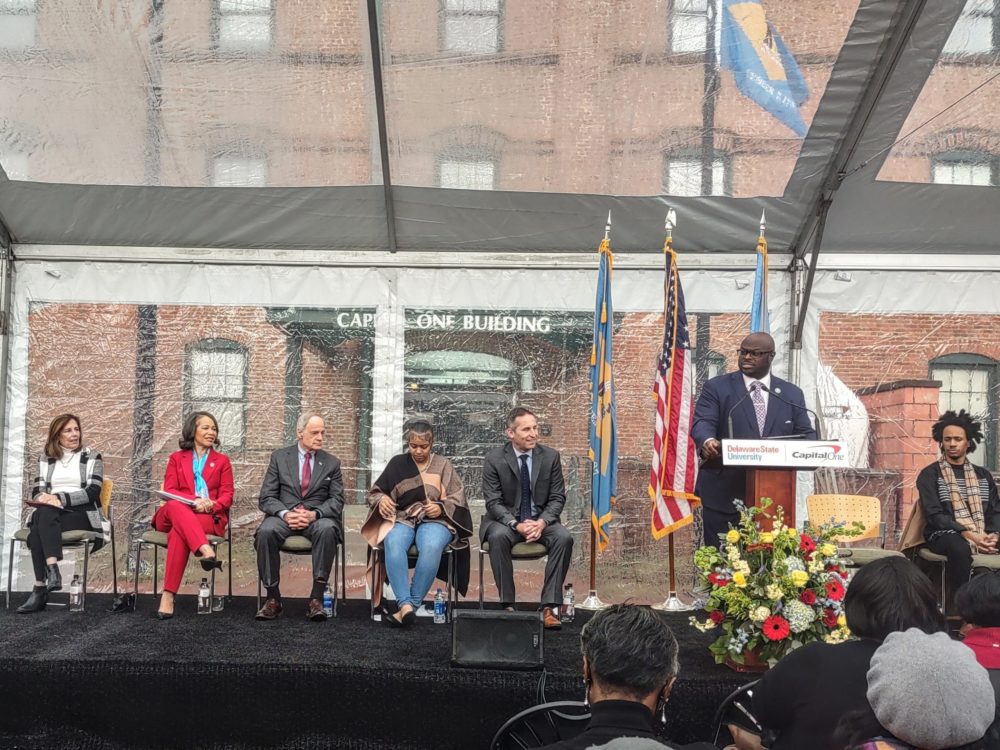Delaware State University, Delaware’s HBCU, made its official return to Wilmington on Friday. The opening event marked a living moment of Black history.
Capital One donated the new campus to Del State last summer. It’s on the Riverfront, and easily accessible to youth, graduate students and workforce development students coming from historically underserved neighborhoods in the city.
The event included speeches from DSU students, university President Dr. Tony Allen, Capital One Delaware Market President Joe Westcott, Gov. John Carney, Wilmington Mayor Mike Purzycki and Delaware’s three US congresspeople, Lisa Blunt Rochester, Chris Coons and Tom Carper.
“Black history is American history,” Allen said in a speech at the building’s ribbon cutting ceremony. “That’s more than a catchphrase. It’s the truth.”
Del State was one of many HBCUs threatened with violence this month, a reality that didn’t stop a large crowd from attending the symbolic event.
“Many of you know that this exact location was an important crossing in the Underground Railroad,” Allen continued. “Wilmington was known in 19th century as the last stop to freedom on the Eastern line. A white businessman named Thomas Thomas Garrett lived just a few blocks away in Quaker Hill and helped Harriet Tubman free thousands through this very spot.”
The proximity to the Underground Railroad route wasn’t figurative or exaggerated. The new campus at 1 S. Orange St. sits facing South Market Street just as it turns into the Market Street Bridge, the drawbridge that crosses the Christina River leading toward New Castle.

The statue at Tubman Garrett Park. (Photo by Holly Quinn)
That bridge is the literal bridge that Tubman crossed multiple times. It’s why the park that the new Del State building faces is called Tubman Garrett Park, with its spectacular sculpture marking the history. Just beyond the Riverfront Market just south of the DSU building you’ll find another historical marker facing the bridge itself.
Inside the building there are impressive views of the river — and of the bridge.
For many Wilmingtonians who cross the bridge daily to Route 13 to and from work or school or the Chase Fieldhouse, it’s easy to forget how profoundly important that stretch of road is (especially if you’re cursing having to wait for the drawbridge).
We have one reminder in the park, honoring Black history of the past. Now, with the new DSU building, the location is also an investment into Black history of the future.
Allen also announced the launch of an executive mentorship program between Capital One executives and Del State sophomores and $270,000 in grants for the university’s experiential learning programs.
The building, which was renovated by ING Direct in the 2000s before it was acquired by Capital One, needs little renovating, with its modern conference room and meeting spaces, though it is expected that some of the space in the six-floor, 35,000-square-foot building will be converted to classroom spaces.
In addition to Del State graduate degree programs and workforce development programs, The Warehouse, a teen-focused center based in Riverside, will have space on the second floor for its RISE (Reaching and Investing in Youth for Sustainable Employment) program, which kicked off last week with the presentation of $500,000 from program partner Barclays US Consumer Bank.

A conference room in the new Del State building. (Photo by Holly Quinn)
Before you go...
Please consider supporting Technical.ly to keep our independent journalism strong. Unlike most business-focused media outlets, we don’t have a paywall. Instead, we count on your personal and organizational support.
3 ways to support our work:- Contribute to the Journalism Fund. Charitable giving ensures our information remains free and accessible for residents to discover workforce programs and entrepreneurship pathways. This includes philanthropic grants and individual tax-deductible donations from readers like you.
- Use our Preferred Partners. Our directory of vetted providers offers high-quality recommendations for services our readers need, and each referral supports our journalism.
- Use our services. If you need entrepreneurs and tech leaders to buy your services, are seeking technologists to hire or want more professionals to know about your ecosystem, Technical.ly has the biggest and most engaged audience in the mid-Atlantic. We help companies tell their stories and answer big questions to meet and serve our community.
Join our growing Slack community
Join 5,000 tech professionals and entrepreneurs in our community Slack today!

The person charged in the UnitedHealthcare CEO shooting had a ton of tech connections

From rejection to innovation: How I built a tool to beat AI hiring algorithms at their own game

Where are the country’s most vibrant tech and startup communities?



